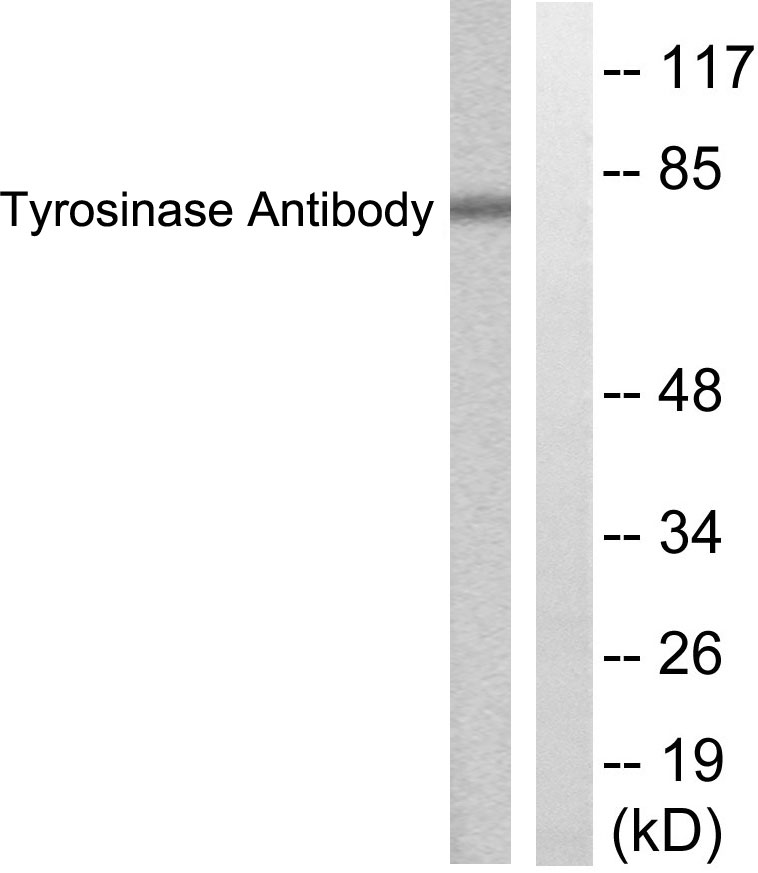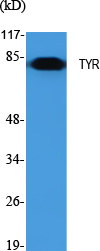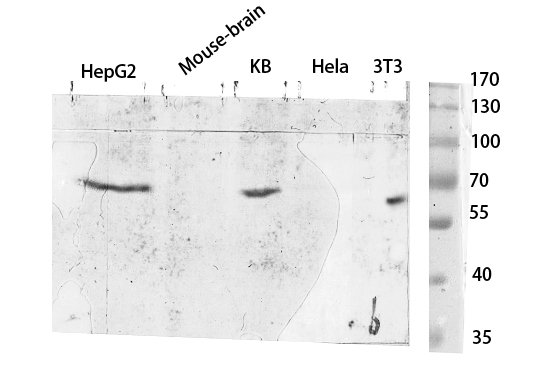产品名称
TYR Rabbit Polyclonal Antibody
别名
TYR; Tyrosinase; LB24-AB; Monophenol monooxygenase; SK29-AB; Tumor rejection antigen AB
存储缓冲液
Liquid in PBS containing 50% glycerol, 0.5% BSA and 0.02% New type preservative N.
Human Gene Link
http://www.ncbi.nlm.nih.gov/sites/entrez?db=gene&term=7299
Human Swissprot No.
P14679
Human Swissprot Link
http://www.uniprot.org/uniprotkb/P14679/entry
Mouse Swissprot No.
P11344
Mouse Swissprot Link
http://www.uniprot.org/uniprot/P11344
免疫原
The antiserum was produced against synthesized peptide derived from human Tyrosinase. AA range:471-520
特异性
TYR Polyclonal Antibody detects endogenous levels of TYR protein.
稀释度
WB 1:500 - 1:2000. ELISA: 1:10000. Not yet tested in other applications.
宿主
Polyclonal, Rabbit,IgG
背景介绍
tyrosinase(TYR) Homo sapiens The enzyme encoded by this gene catalyzes the first 2 steps, and at least 1 subsequent step, in the conversion of tyrosine to melanin. The enzyme has both tyrosine hydroxylase and dopa oxidase catalytic activities, and requires copper for function. Mutations in this gene result in oculocutaneous albinism, and nonpathologic polymorphisms result in skin pigmentation variation. The human genome contains a pseudogene similar to the 3' half of this gene. [provided by RefSeq, Oct 2008],
组织表达
Liver,Melanoma,Skin,T-cell,
细胞定位
Melanosome membrane ; Single-pass type I membrane protein . Melanosome . Proper trafficking to melanosome is regulated by SGSM2, ANKRD27, RAB9A, RAB32 and RAB38. .
信号通路
Tyrosine metabolism;Riboflavin metabolism;Melanogenesis;
功能
catalytic activity:L-tyrosine + L-dopa + O(2) = L-dopa + dopaquinone + H(2)O.,cofactor:Binds 2 copper ions per subunit.,disease:Defects in TYR are the cause of oculocutaneous albinism type I temperature-sensitive (OCA-ITS) [MIM:606952]. OCA-ITS patients have white axillary and scalp hair and pigmented arm and leg hair.,disease:Defects in TYR are the cause of oculocutaneous albinism type IA (OCA-IA) [MIM:203100]. OCA-I, also known as tyrosinase negative oculocutaneous albinism, is an autosomal recessive disorder characterized by absence of pigment in hair, skin and eyes. OCA-I is divided into 2 types: type IA, characterized by complete lack of tyrosinase activity due to production of an inactive enzyme, and type IB characterized by reduced activity of tyrosinase. OCA-IA patients presents with the life-long absence of melanin pigment after birth and manifest increased sensitivity to ultraviolet radiation and to predisposition to skin cancer.,disease:Defects in TYR are the cause of oculocutaneous albinism type IB (OCA-IB) [MIM:606952]; also known as albinism yellow mutant type. OCA-IB patients have white hair at birth that rapidly turns yellow or blond. They manifest the development of minimal-to-moderate amounts of cutaneous and ocular pigment.,function:This is a copper-containing oxidase that functions in the formation of pigments such as melanins and other polyphenolic compounds. Catalyzes the rate-limiting conversions of tyrosine to DOPA, DOPA to DOPA-quinone and possibly 5,6-dihydroxyindole to indole-5,6 quinone.,induction:Increased expression after UV-B radiation.,online information:Retina International's Scientific Newsletter,online information:Snowy stardom - Issue 49 of August 2004,online information:TYR mutations,online information:Tyrosinase entry,polymorphism:Compound heterozygosity for the R402Q polymorphism and a mutant allele of TYR is a common cause of autosomal recessive ocular albinism. The R402Q polymorphism is also found in Waardenburg syndrome type II with ocular albinism (WS2-OA) in association with a deletion in the MITF gene.,polymorphism:Genetic variations in TYR are associated with skin/hair/eye pigmentation type 3 (SHEP3) [MIM:601800]. Hair, eye and skin pigmentation are among the most visible examples of human phenotypic variation, with a broad normal range that is subject to substantial geographic stratification. In the case of skin, individuals tend to have lighter pigmentation with increasing distance from the equator. By contrast, the majority of variation in human eye and hair color is found among individuals of European ancestry, with most other human populations fixed for brown eyes and black hair.,similarity:Belongs to the tyrosinase family.,
纯化
The antibody was affinity-purified from rabbit antiserum by affinity-chromatography using epitope-specific immunogen.


.jpg)

